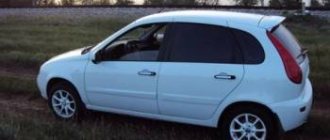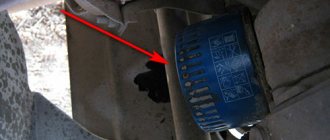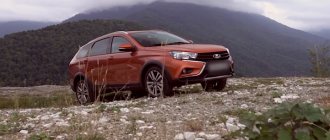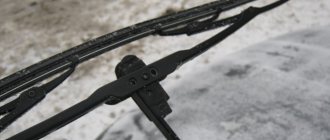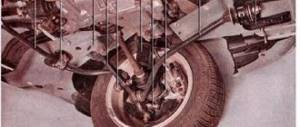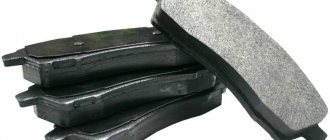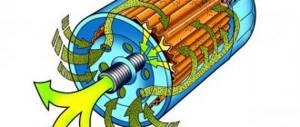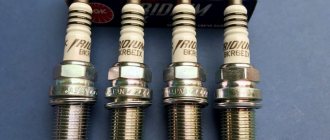Body type Datsun Mi-Do and Lada Kalina
When looking at the bodywork, it becomes clear that Kalina is a more practical car.
Lada Kalina station wagon is a practical choice.
This is proven by the absence of sedans in its range, as well as the presence of a station wagon, Cross and Sport versions.
Kalina Cross looks even more powerful.
This model is also suitable as a youth model, and a summer resident will certainly like it.
The hatchback is very stylish and modern.
Datsun, on the contrary, lacks the “wagon” modification, but has a sedan.
The Sport version compares favorably with the stock modifications.
Consequently, both of these models, in their target niche, only partially overlap.
The stern of the Datsun Mi-Do is almost like that of the Kalina. But the fifth door is different.
As you can see, on-Do and mi-Do are more modern and presentable. It’s not for nothing that Russia is called “the country of sedans.”
However, the popularity of hatchbacks is not falling either.
test drive on the Women's car portal Careta.info
The revived Datsun brand in Russia, if not breaking records, certainly does not look pale: sales of on-Do and mi-Do are at a very good level, despite all the skeptical remarks addressed to them and comparisons with Lada. The brand itself was “pulled out of the bins” of Nissan, where it had lain for almost forty years. In those years, it was the main brand of the company, later known as Nissan, and cars under this brand managed to travel on the roads of Russia in the early nineties. Its revival as a budget localized brand is a good sign: it means that Renault-Nissan is ready to use the fruits of Russian engineering under its own brand, albeit not the main one, after some modification.
The comparison of the car with the Lada Kalina is obvious, but Datsun should not be considered just another modification of it. Modern cars differ from each other in nuances, in prioritization and execution details, so in mi-Do there is a slightly different atmosphere, an attempt to make the car “more different”, first of all, more Japanese. And don’t be misled by changes in appearance: unlike the old Soviet school of “modernization,” when the car’s plumage and external panels changed over and over again, leaving its essence unchanged, here the appearance was changed not at all for show and “mastering a new model by the XVIIIIIIIIIIIIIII Congress of the CPSU,” but just to emphasize that the car is now completely different. Yes, it was not possible to hide the relationship, but such a task was clearly not set. Judging by the reviews of those who were involved in fine-tuning this car, the goal was different - to change the approach to quality of workmanship as much as possible, increase reliability and give the car more thoroughbred driving habits.
As for reliability, they clearly decided to take the reinsurance route. The most reliable and simplest of the entire line of VAZ engines is the eight-valve 11186 with a power of 87 hp, the Japanese Jatco automatic transmission and the complete absence of any complex units, proven components and selection of suppliers to ensure maximum quality performance. I would say that for a cheap car it turned out well, the only serious irritants in the cabin were the inexpensive seats, the sound of the turn signal beeper and the somewhat strange working brakes, however, the latter is clearly a feature of a particular instance.
The rest of the interior is even pleasant: it does not rattle too much, is made of cheap but not irritating materials, and has a clear instrument panel. It is not too different from the platform Kalina, but there are fewer minor assembly flaws that manifest themselves in the form of clicks or poor operation of covers, latches and handles. In the future, the differences will disappear - according to the agreement between the companies, all Datsun innovations will be implemented on Kalinas, which means that all the pleasant changes will appear on Ladas very soon. And the main change that is worth waiting for is noise insulation; oddly enough, the new approach is making itself felt. No, the car has not become a “six hundredth” and is even far from any Octavia, but obvious flaws have been removed in the form of noise from the wheel arches and increased noise in the rear seats, interior creaks and knocks, even the rear wiper is now quiet. The engine sounds as usual, maybe a little muffled, but the new automatic transmission is responsible for the complete absence of transmission noise; with it, the quiet howls so familiar to all VAZ drivers, which are especially annoying when braking the engine, disappear. Otherwise, we can hope for work on selecting component suppliers and improving the painting process, changing the range of steels used for body production and other seemingly subtle changes. Unlike garage tuning products, ease of maintenance and weight of the car are taken into account.
The roots, however, can be felt: the high Kalinovsky seating position has not disappeared anywhere, the seats have changed minimally, and I hope that they will soon be replaced with something significantly more advanced in terms of seating comfort. The eye comes across technical solutions that are familiar to everyone who has driven a Zhiguli, such as a thin handbrake leg sticking straight out of the floor, floor mats with an “overlap” across the central tunnel at the rear, thin sun visors - in general, the birthmarks of the old platform. There’s probably no point in hiding them and abandoning the basics. VAZ will have a new platform, more modern and convenient, and it will be necessary to use it, and not engage in cosmetic improvements to the old one, for now the task has been achieved. Minimal modifications have changed the quality of workmanship and driving characteristics.
While the interior dimensions remain minimally sufficient to accommodate four people, it is already too cramped for five. The trunk can accommodate a couple of small suitcases and that’s all; fortunately, you can fold down the rear seats and transport something significant. Here, even Nissan’s intervention cannot squeeze even more space out of the old body; it is clearly visible that the platform is already outdated. But the upholstery is now made of a material that is pleasant to the eye and to the touch, there are no bolts or sharp edges sticking out, everything is fine with this.
The new suspension settings pleasantly change the behavior of the car: it is less imposing and much closer to the “best examples”, but with a good emphasis on all-terrain capability and a slight indifference. Moreover, the shock absorbers here are the same SAAZ, but tuned, and the stiffness characteristics of the body and some other suspension elements have been slightly changed. In comparison with the previous generation, Kalin is heaven and earth; in comparison with the current one, the car is simply more pleasant to drive, but you can’t immediately understand why. Unfortunately, the electric booster is not installed here as a “driver” type, only a model that reduces the “steering feel”, making it lighter and less sensitive. I remember that during the test drive of the Granta liftback, the steering feel was much more pleasant, although sometimes the steering wheel was even too heavy in turns. But judging by the fact that Datsuns are fundamentally equipped with not the most powerful engine available, they did not strive for sportiness at all.
But the duet of the latest modification of the good old engine, which traces its ancestry back to the 1300 cc 2108 developed by Porsche and the Japanese four-speed automatic, is very good, perhaps even more pleasant to drive than the same automatic transmission with a 98-horsepower VAZ engine. The eight-valve engine pulls noticeably better at low speeds, and the automatic does not try to pull until the last minute, easily shifting down when there is a lack of traction. In the city, this couple drives very cheerfully, as long as there are no more than one or two passengers in the car, and with a full interior, the car cannot even handle a sixteen-valve manual transmission. Some credit for the feeling of dynamics must be given to the noise insulation; it makes cranking the engine “ringing” not too tiring for the ears. By the way, unlike the Granta, the temperature indicator here is not hidden in the depths of the screen on the dashboard, but is displayed constantly, forcing us to remember once again that for a long and happy engine service, warming up cannot be neglected. A small portion of nostalgia awaits you under the hood - there are no newfangled plastic covers covering the engine, you will be greeted by the valve silhouette that is painfully familiar to all owners of “Nines”. But the clamps are new, the material of the hoses and tanks is clearly different, they didn’t overdo it with nostalgia.
In general, the car does not stand out at all, the flaws of the platform have been very neatly removed, and this is its main advantage. The car was carefully preserved with a decent level of cross-country ability, high ground clearance - almost like other crossovers - and small overhangs. And at the end we get... yes, this is definitely a Datsun, not a Lada at all, with its rollicking, cheapness and inattention to detail, traditional indifference to all the characteristics of the suspension, except for “omnivorousness” and strength. It’s nice to know that little by little AvtoVAZ cars will learn to do the same, with attention and respect for simple driver needs, carefully and with love, and mi-Do acts as a trial balloon, and if it is popular, it will become a symbol that people want change. in this direction.
We thank the friendly project Maximalka.com for the photos.
Boris Ignashin
careta.info
Differences between Datsun Mi-Do and Lada Kalina in exterior
Here you can only correctly compare Kalina and Datsun in a hatchback body, in order to equalize the chances as much as possible. Externally, the Lada looks impressive, some believe even too impressive. The huge “mouth” of the air intake, which occupies more than half of the front bumper, immediately catches your eye. A narrow and long radiator grille, stylish head optics and small foglights - this is the full face of the model. In profile, Kalina is moderately swift, and her stern, decorated with elongated feet and reflectors, looks modest, complementing the picture.
The Datsun Mi-Do generally repeats the image of the domestic model. But the nuances are noticeably different. Its front end, although not as impressive, is much more proportional - the combination of a trapezoidal air intake, radiator grille and its chrome trim looks very harmonious. There are almost no differences in profile, and the rear differs noticeably only in the configuration of the rear door.
Mi-Do is made more traditionally.
The Datsun sedan is copied from the Granta - it looks expressive and calm. And the station wagon from Kalina successfully combines a certain aggression with “thriftiness”.
How much does a machine gun cost for people?
Today they do not make affordable cars with an automatic transmission either in the form of Renault Logan or Sandero. Frets have switched from imported boxes to more economical robots, but not yet understood by drivers. But Datsun, I’m sure, got it right with the automatic.
Together with the city model Datsun mi-Do, the Dream package appeared with a hydromechanical automatic transmission - the dream of pensioners. And even though it has only 4 gears, while the Koreans are already using 6-speed gears with all their might, the assembly of the unit is Japanese, which means there should be no issues with quality.
The Datsun-mi-Do hatchback itself is assembled in the workshops that were built for Kalina at AvtoVAZ. Gasoline engine 1.6 (87 hp), transmission - 4-speed automatic or 5-speed manual. The automatic is quieter, but consumes 1-2 liters more fuel. Price of basic versions: 415 - 465 thousand rubles.
The body, let’s hope, like the automatic transmission, will last a long time, because it has galvanized parts, and a guarantee against through corrosion for 6 years. We know the automatic from Nissan's small class models, and the body from Kalina, let them now compete in longevity.
Our Datsun Mi does not have navigation, you can order it, but I wouldn’t do it, it’s much cheaper to just buy a navigator. The air conditioning system works well. Buy yourself a heated windshield too. The USB input is hidden behind the glove compartment lid. It’s a pity, they got rid of the top box on the center console that Kalina has. But I couldn’t get rid of the scratchy burrs of explosive plastic.
Engines Datsun Mi-Do and Lada Kalina
In this regard, Lada undoubtedly wins. After all, it has twice as many power units in its lineup, and one of them overlaps with that of Datsun. All rival engines have a volume of 1.6 liters with an in-line layout and the presence of an injector, but their power varies noticeably. So, Datsun has only 82- and 87-horsepower units in its arsenal. Moreover, the first one is completely 8-valve. Peak power for these engines is achieved at 5,100 rpm, while thrust is 132 Nm (3,800 rpm) and 140 Nm (3,800 rpm), respectively.
On-do and mi-do are able to offer customers only basic units.
Regarding Kalina, it does not have an 82-horsepower engine. But there are more powerful ones - this is a 98-horsepower engine (5,600 rpm) with a thrust of 145 Nm (4,500 rpm), as well as a 106-horsepower (5,800 rpm) with a return of 148 Nm (4,000 rpm). There is also a sports version of this model, with an output of 118 hp. With. (6,750 rpm) and a torque of 154 Nm (4,750 rpm).
Kalina's engines are noticeably more powerful than Datsun's.
Therefore, if you need a powerful engine, then Kalina is preferable.
Comparison of Datsun Mi Do and Kalina
Datsun mi-do or Lada Kalina
Datsun mi-Do or Lada Kalina 2 is a question that worries many who will soon decide to update their fleet and are now painfully choosing the future “iron horse”. Because both models have a lot in common, which makes the choice much more difficult. Our dtsun mi test with test drives and comparisons does not differentiate dtsun mi from viburnum. However, there are many differences. As it turns out, before purchasing one of the 2 models, you need to correctly understand what is required from the car.
Daqun is more prestigious than Kalina
It cannot be said that Datsun is even more popular than VAZ, especially since they are collected on the same sites. But the psychology of the Russian consumer is structured in such a way that the majority of buyers at car dealerships love foreign cars. Is there a test drive of the Datsun-mi hatchback or a comparison of the driving characteristics of the viburnum and mi-do? That is why many of them, all other things being equal, specifically choose Datsun - the “Japanese roots” make themselves felt.
Mi-Do is obviously quoted above Kalina.
Body type Datsun Mi-Do and Lada Kalina
When you look at the body palette, it becomes clear that Kalina is a more comfortable car.
Lada Kalina Station Wagon is a convenient choice.
This is proven by the absence of sedans in its series, as well as the presence of station wagon, cross and sport versions.
Kalina Crest looks even stronger.
This model is suitable for both youth and country people, you will probably like it.
The hatchback is very elegant and modern.
The Datsun, on the other hand, lacks the "car" modification, but it does have a car.
The sports version compares favorably with the stock version.
Therefore, both of these models only partially overlap their motivated niches.
The harsh Datsun Mi-do is almost like Kalina . But the heel door is different.
As you can see, he-mi-i-mi is more modern and presentable. It’s not for nothing that Russia is called “the country of sedans.”
However, the popularity of hatchbacks is also not falling.
Datsun and Kalina suspension - differences
Structurally, the chassis of Dastun and Lada is identical. The front axle has MacPherson struts, while the rear axle has a torsion beam. This design is typical for class B. The models' handling is not bad, and road stability is also at a good level. Of course, the high ground clearance affects sharp turns, but these are not cars for racing.
There are no structural differences in the competitors' chassis.
Therefore, in this regard, he-Do and Kalina have parity.
Datsun mi-Do. How is it better than Kalina?
Serious work on mistakes is evident. The disadvantages of the Kalina family in Vesta were turned into advantages! It seems to me that the transition from Kalina to Vesta will cause delight, because... she will play in contrast. It's just the price that doesn't please me. And Vesta must be compared with more expensive cars.
Related articles:
In its home market, the Datsun Cross appeared before the general public at the beginning of winter 2020.…
Russian Datsun cars will finally receive a more powerful engine, which many car enthusiasts have been missing. Let us remind you...
Car enthusiasts are interested in who will emerge as the leader in the “car battle” Lada Granta vs Datsun on-Do. It’s clear to say which one...
The charged version of Lada Kalina 2 is already on the roads of the country. The second generation of the five-door hot hatch has been in production for a week now...
Comparison of Datsun Mi-Do and Lada Kalina salons
The interior of the cars is also similar. Thus, the interior of the Datsun is designed following the example of that of the Granta. The outline of the dashboard shows common lines - the location and shape of the air deflectors, 3-spoke steering wheels, a similar configuration of the center console, glove box, cup holders, dashboard style, location of controls and other aspects.
The Datsun's interior is more traditional.
The seats are similar - they are well profiled, but the lateral support is clearly insufficient. The rear seat is comfortable in both models, and the high enough roof allows most passengers not to have their heads propped up against the ceiling.
Kalina's interior is also quite good.
All this is also true for Kalina. Therefore, the internal world of machines is equivalent.
Prices and configurations of Kalina and Datsun Mi-Do
Despite the fact that the starting price tag for both models differs extremely slightly - 376,300 rubles. for Kalina (Standard version) and 376,000 for Datsun (Access version) - it is worth considering that for this amount the Japanese sedan will be much better equipped in terms of safety.
The Datsun base is richer in equipment.
So, Kalina can only offer an airbag for the driver, ISOFIX type fastenings, radio preparation, electric lifts (front windows only), BC and central locking. And Datsun is able to add electronics to this set in the form of ABS, EBD and EBA systems. More advanced trim levels – “Norma” and “Lux” for Kalina, as well as Trust and Dream for Datsun – can already boast a pair of front airbags (and the “Japanese” also have side airbags), an ESP system, 15-inch “titanium” airbags, full power accessories, fog lights, heated seats and mirrors, air conditioning (climate control for Datsun), audio system with acoustics and display, Bluetooth, parking sensors, navigation and other options.
Top modifications of Kalina will receive automatic transmission and other benefits.
Regarding the cost, the limit for Kalina is 540,800 rubles. (for a station wagon), while for Datsun it is 539,000 rubles. for E-Do. The on-Do sedan is cheaper - 492,000 rubles.
